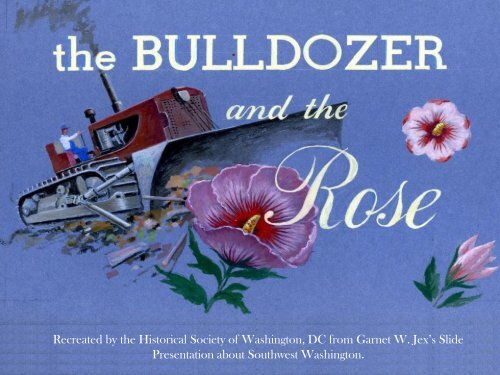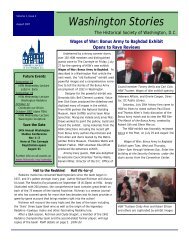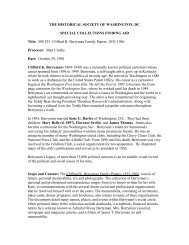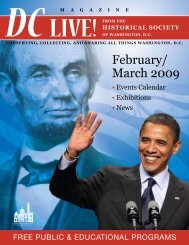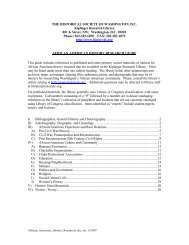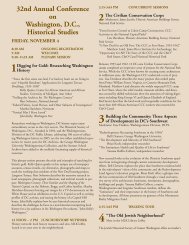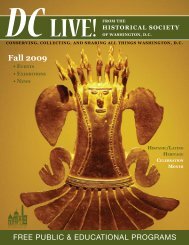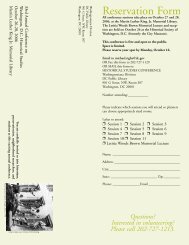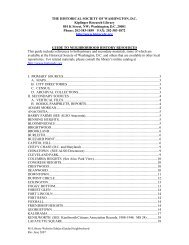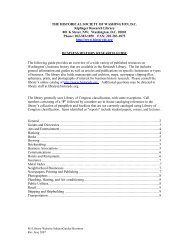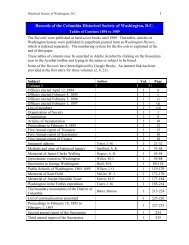Bulldozer and the Rose - The Historical Society of Washington, DC
Bulldozer and the Rose - The Historical Society of Washington, DC
Bulldozer and the Rose - The Historical Society of Washington, DC
You also want an ePaper? Increase the reach of your titles
YUMPU automatically turns print PDFs into web optimized ePapers that Google loves.
Recreated by <strong>the</strong> <strong>Historical</strong> <strong>Society</strong> <strong>of</strong> <strong>Washington</strong>, <strong>DC</strong> from Garnet W. Jex’s Slide<br />
Presentation about Southwest <strong>Washington</strong>.
Introduction<br />
It has always been interesting to come back to<br />
Southwest <strong>Washington</strong> <strong>and</strong> see <strong>the</strong> great changes<br />
that have taken place since I first knew it .... since <strong>the</strong><br />
1920‘s when I worked at <strong>the</strong> old Army Medical<br />
Museum, <strong>and</strong> <strong>the</strong>n again, beginning in 1948, when our<br />
Public Health Service Graphics Section was moved to<br />
H E W‘s South Building.<br />
My work has been in <strong>the</strong> graphic arts field all <strong>the</strong>se<br />
years. I‘m a weekend <strong>and</strong> vacation l<strong>and</strong>scape painter,<br />
<strong>and</strong> have always carried along a camera.<br />
For several years ,in putting on this Southwest show, I<br />
shared <strong>the</strong> time with my old P. H. S. friend, Dana<br />
Doten. His chief interest was in <strong>the</strong> sociological side,<br />
in city planning; <strong>and</strong> in his information job he‘s a<br />
master <strong>of</strong> <strong>the</strong> English language.
Before I retired in ‗62, our old<br />
Virginia car pool used to be<br />
greeted this way at <strong>the</strong> District<br />
end <strong>of</strong> <strong>the</strong> 14th street bridge.<br />
<strong>The</strong>n we‘d cut across <strong>the</strong><br />
Southwest to our parking<br />
space, <strong>and</strong> on foot dodge <strong>the</strong><br />
traffic to our several buildings
For years I‘d read about plans<br />
for ―redeveloping‖ Southwest<br />
<strong>Washington</strong>, but nothing ever<br />
seemed to happen. <strong>The</strong>n it did<br />
....<br />
A fine old 1870 house , with its<br />
Mansard ro<strong>of</strong>, near Virginia or<br />
Maryl<strong>and</strong> Avenues, would be<br />
ab<strong>and</strong>oned; <strong>the</strong>n <strong>the</strong> wreckers<br />
got to it, <strong>and</strong> suddenly it was<br />
gone. ―Gee, some <strong>of</strong> this stuff<br />
ought to be painted,‖ I would<br />
say. But by <strong>the</strong> time a weekend<br />
rolled around, it would be too<br />
late,...
For only this was left—a pattern<br />
on an adjoining wall, <strong>and</strong> a<br />
scraggly little tree in front yard<br />
debris. <strong>The</strong>se rectangles <strong>of</strong> color<br />
—our ―playing card pattern‖ <strong>of</strong><br />
wall-paper <strong>and</strong> paint— became a<br />
Southwest trademark.<br />
After missing out on a few fine old<br />
houses, in early 1958 I began to<br />
use my trusty little camera,<br />
sometimes also during <strong>the</strong> week,<br />
<strong>and</strong> put toge<strong>the</strong>r ideas for <strong>the</strong><br />
history <strong>and</strong> o<strong>the</strong>r sketches.
As I got deeper into <strong>the</strong> project<br />
<strong>and</strong> its significance, a title<br />
suggested itself: <strong>the</strong> BULLDOZER<br />
could symbolize <strong>the</strong> destruction <strong>of</strong><br />
old Southwest; <strong>and</strong> <strong>the</strong> ROSE,<br />
really <strong>the</strong> perennial shrub, <strong>the</strong><br />
<strong>Rose</strong> <strong>of</strong> Sharon, that grew<br />
pr<strong>of</strong>usely in fenced-in front yards -<br />
could represent <strong>the</strong> human values,<br />
persistent human values, now so<br />
violently uprooted.
<strong>The</strong>n what a pleasure it was<br />
one day to bump into my friend<br />
Dana, also poking around,<br />
watching what happened to<br />
people, as <strong>the</strong> old town came<br />
down <strong>and</strong> <strong>the</strong> new one went up<br />
. . . in this so-called<br />
REDEVELOPMENT in<br />
Southwest <strong>Washington</strong>.
<strong>The</strong> Southwest Section is<br />
roughly one square mile in<br />
size, almost a triangle in<br />
shape. It is practically in <strong>the</strong><br />
center <strong>of</strong> <strong>the</strong> <strong>Washington</strong><br />
Metropolitan area; <strong>the</strong>refore<br />
it has geographical<br />
importance. No longer<br />
could it remain an economic<br />
―wastel<strong>and</strong>.‖<br />
Across its top runs <strong>the</strong> Mall,<br />
Uncle Sam‘s ―Front Yard.‖
From <strong>the</strong> Capitol steps we look westward down <strong>the</strong> vast green<br />
―lawn‖ <strong>of</strong> this showplace.
Past <strong>the</strong> <strong>Washington</strong><br />
Monument in <strong>the</strong><br />
middle…
Tom Jefferson is just <strong>of</strong>f <strong>the</strong> left…
And Abraham Lincoln presides over <strong>the</strong> west end. We‘re<br />
all very proud <strong>of</strong> Uncle Sam‘s ―Front yard‖.
Close-by <strong>the</strong> Capitol is this fountain in <strong>the</strong> Botanic<br />
Garden which edges over into <strong>the</strong> Southwest, a<br />
delightful spot <strong>of</strong> color, BUT…
About as far away, as from<br />
home plate on a baseball<br />
field to <strong>the</strong> left-fielder‘s<br />
position, ANOTHER<br />
Southwest began: alley<br />
dwellings, poverty, outdoor<br />
privies ---two-thirds <strong>of</strong> old<br />
Southwest had outdoor<br />
privies…
A wash hung out over a vacant lot; broken glass,<br />
weeds <strong>and</strong> stones…
Paint peeling from desolate<br />
little row houses, but our<br />
<strong>Rose</strong> <strong>of</strong> Sharon in full<br />
bloom. For years <strong>the</strong> press<br />
made much <strong>of</strong> this<br />
anomaly, but nei<strong>the</strong>r <strong>the</strong><br />
City nor Congress seemed<br />
to care.
<strong>The</strong> story goes way back, before<br />
1800. Georgetown is already<br />
thriving. Hamburg, in Foggy<br />
Bottom‖, is chiefly a real estate<br />
venture; Carrollsburg <strong>the</strong> same.<br />
―Jenkins Hill‖ rises where<br />
swampy Tyber Creek divided,<br />
<strong>the</strong> main stream going westward<br />
to <strong>the</strong> Potomac, while some <strong>of</strong><br />
its water goes southward, back<br />
<strong>of</strong> ―Duddington Pasture‖, into<br />
James Creek <strong>and</strong> <strong>the</strong><br />
confluence <strong>of</strong> <strong>the</strong> Potomac <strong>and</strong><br />
<strong>the</strong> Anacostia. Thus <strong>the</strong> name<br />
―<strong>The</strong> Isl<strong>and</strong>‖, for it was ringed by<br />
water.
And <strong>The</strong> Isl<strong>and</strong> it would be called by generations <strong>of</strong> Southwest people. From<br />
among <strong>the</strong>m Alex<strong>and</strong>er Shepherd became Governor <strong>of</strong> <strong>the</strong> District <strong>of</strong> Columbia, a<br />
different ruling set-up than now. <strong>The</strong> Noyes family founded <strong>the</strong> ―Evening Star‖.<br />
<strong>The</strong> late Charles Stanley White became a famous surgeon <strong>and</strong> a founder <strong>of</strong> D. C.<br />
Doctor‘s Hospital; his bro<strong>the</strong>r also nicknamed ―Doc‖, a World Series pitching star<br />
for <strong>the</strong> old Chicago White Sox. <strong>The</strong> record goes on <strong>and</strong> on.<br />
Some less adventurous people never left <strong>The</strong> Isl<strong>and</strong>, between<br />
cradle <strong>and</strong> grave. (Similarity, Cade‘s Cove, Tenn., in <strong>the</strong> Great<br />
Smokies)
In <strong>the</strong> 1850‘s <strong>the</strong> bed <strong>of</strong><br />
old Tiber Creek became<br />
an extension <strong>of</strong> <strong>the</strong> C &<br />
O. Canal. At <strong>the</strong> foot <strong>of</strong><br />
Jenkins Hill, on which <strong>the</strong><br />
new Capitol was under<br />
construction, one branch<br />
<strong>of</strong> <strong>the</strong> Canal followed<br />
James Creek to <strong>the</strong><br />
Arsenal on <strong>the</strong> point;<br />
ano<strong>the</strong>r to <strong>the</strong> Anacostia<br />
with its deeper water,<br />
where ships could dock.
Here‘s <strong>the</strong> view down <strong>the</strong> wide Potomac from Greenleaf Point,<br />
or Buzzards Point near-by; here Indian chiefs once powwowed,<br />
<strong>and</strong> L‘Enfant‘s idea for a fort was carried out.
Fort McNair today.<br />
―Generals‘ Row‖<br />
across <strong>the</strong> green. Big<br />
military names have<br />
trained <strong>and</strong> lived here.<br />
Tragedy recorded in<br />
1814 (when <strong>the</strong> British<br />
burned <strong>Washington</strong>);<br />
again with a munitions<br />
explosion during <strong>the</strong><br />
Civil War.
On April 18, 1861, five<br />
days after Fort Sumter fell,<br />
here is Colonel Robert E.<br />
Lee riding across<br />
Southwest‘s Long Bridge to<br />
his Arlington home, after<br />
declining comm<strong>and</strong> <strong>of</strong> <strong>the</strong><br />
Union Army, <strong>of</strong>fered to him<br />
by General Winfield Scott.
And in July 1865, within this<br />
building, once part <strong>of</strong> a<br />
penitentiary on <strong>the</strong> McNair<br />
campus, was held <strong>the</strong> trial <strong>of</strong><br />
<strong>the</strong> conspirators in <strong>the</strong> Lincoln<br />
assassination plot. Four <strong>of</strong> <strong>the</strong>m<br />
were hanged from a scaffold<br />
behind a fence about where <strong>the</strong><br />
trees are now - - George<br />
Atzerodt, David Herold, Lewis<br />
Payne, <strong>and</strong> Mrs. Mary E.<br />
Surratt, all with hoods over <strong>the</strong>ir<br />
heads
This building, now<br />
demolished, on 7th Street<br />
just south <strong>of</strong> Independence<br />
Avenue, was on <strong>the</strong> site <strong>of</strong><br />
Williams‘ slave pen, where<br />
slaves were bought <strong>and</strong><br />
sold. On 8th Street a<br />
colored church was<br />
involved in helping slaves<br />
escape to <strong>the</strong> North by <strong>the</strong><br />
Underground Railroad.
Right in <strong>the</strong> middle <strong>of</strong> <strong>the</strong> old<br />
Isl<strong>and</strong>, on <strong>the</strong> highest ground, is<br />
St. Dominic‘s, whose l<strong>and</strong>mark<br />
spire used to dominate <strong>the</strong><br />
skyline from far away, especially<br />
as you came across <strong>the</strong> River<br />
— <strong>and</strong> before being dwarfed<br />
now by cement <strong>and</strong> glass<br />
Government palaces.
Our city‘s history tied in with many old buildings. Multifamily ―Wheat Row‖,<br />
on 4th Street near N, built in 1794 by a Supreme Court Justice, as a<br />
speculation, before <strong>the</strong> Government moved to <strong>Washington</strong>, planning to<br />
walk from his home here to Capitol Hill.<br />
Now <strong>the</strong>y‘ve painted <strong>the</strong> lovely old red brick a shining cream to match<br />
<strong>the</strong> new stuff joined to it.
<strong>The</strong> 1796 Law-Lee house, near <strong>the</strong> waterfront: ―Honeymoon House‖ for<br />
Martha <strong>Washington</strong>‘s gr<strong>and</strong>daughter, Elizabeth Parke Custis, <strong>and</strong> her<br />
English husb<strong>and</strong>, Thomas Law. An uncle <strong>of</strong> Robert E. Lee lived here later.<br />
All painted over now.
At <strong>the</strong> right, <strong>the</strong> Cranch-Duncanson House, which later became <strong>the</strong><br />
Barney Settlement House; at <strong>the</strong> left, <strong>the</strong> <strong>Washington</strong>-Lewis House,<br />
where Ernie Pyle once lived.<br />
In 1814 both were spared because British troops billeted in <strong>the</strong>m. All four <strong>of</strong><br />
<strong>the</strong>se houses have been saved again by <strong>the</strong> strong appeal <strong>of</strong> local architects,<br />
especially <strong>the</strong> late L. Morris Leisenring whom many <strong>of</strong> us knew. RLA has<br />
worked <strong>the</strong>m over, <strong>and</strong> joined <strong>the</strong>m up with new construction beside <strong>the</strong>m.
Like a Scottish castle — <strong>the</strong> old brownstone<br />
Smithsonian, beside <strong>the</strong> Mall.
We guessed that maybe a Director once lived<br />
here, only a block away.
<strong>The</strong> wreckers got to it.
Near-by were solid brick row houses. Employees, no doubt, who could<br />
come home for lunch, <strong>and</strong> walk over to <strong>the</strong> city sometimes.
<strong>The</strong> wreckers got to<br />
<strong>the</strong>m: — in <strong>the</strong> way <strong>of</strong><br />
<strong>the</strong> proposed 10th Street<br />
Mall. Even <strong>the</strong> old<br />
Smithsonian castle was<br />
threatened. Sacrilege.<br />
Ano<strong>the</strong>r new plan was to<br />
―beautify‖ it with a moat<br />
<strong>of</strong> water all around.
Comfortable 3-storey houses<br />
near <strong>the</strong> Agriculture<br />
Department. Owners had<br />
worked <strong>the</strong>m over—<br />
Georgetown style; but <strong>the</strong>y<br />
were evicted after appeals to<br />
court had failed.
How lovely <strong>the</strong>se five pairs<br />
<strong>of</strong> row houses must have<br />
been when new, about<br />
1870.<br />
<strong>The</strong> two houses in each<br />
pair were linked toge<strong>the</strong>r in<br />
design, <strong>and</strong> <strong>the</strong> pairs<br />
alternated - brick <strong>the</strong>n<br />
frame. Note <strong>the</strong> pattern in<br />
<strong>the</strong> slate <strong>of</strong> <strong>the</strong> sloping<br />
ro<strong>of</strong>, <strong>and</strong> <strong>the</strong> intricately<br />
modeled ornamentation<br />
about <strong>the</strong> windows.
Down <strong>the</strong>y came, <strong>and</strong> I doubt if a single architect gave<br />
a damn, except a few sentimental old-timers.<br />
What could present-day Georgetowners have<br />
done with <strong>the</strong>se, so individual in design?
But all houses weren‘t<br />
architectural gems. In some<br />
areas, ―little‖ people had<br />
modest places —a raft <strong>of</strong><br />
kids, dogs <strong>and</strong> cats, <strong>and</strong> a<br />
few flowers behind fences.
Poverty <strong>and</strong> our <strong>Rose</strong> in <strong>the</strong> shadow <strong>of</strong> Federal ―palaces‖. That‘s <strong>the</strong> G S A<br />
Building beyond; <strong>the</strong> H U D Building now fills <strong>the</strong> foreground.
Bubble gum <strong>and</strong> hollyhocks. Most any kid would pose<br />
for a dime
Living down under <strong>the</strong><br />
gashouse; cobblestone<br />
streets, <strong>and</strong> <strong>the</strong> dog-pound<br />
not far away.
This kind <strong>of</strong> housing had to go!!... whe<strong>the</strong>r on designated city streets<br />
or in alleys that sometimes bore odd, ―picturesque‖ names.
Too many people trying to live like this....
Here‘s <strong>the</strong> Congo in <strong>the</strong><br />
foreground, a crude<br />
outdoor privy, <strong>and</strong> in <strong>the</strong><br />
background---our own<br />
Department, dedicated to<br />
Health, Education <strong>and</strong><br />
Welfare !!
Yet people try. Our ―Madonna‖<br />
shot.(Emily‘s)<br />
A Philippino mo<strong>the</strong>r <strong>and</strong> her child<br />
by an American soldier, making<br />
<strong>the</strong> best <strong>of</strong> it in a house where<br />
<strong>the</strong> D. C. Health Department put<br />
on a demonstration in rat control.<br />
Smart, fat rats didn‘t wait for<br />
demolition; <strong>the</strong>y evacuated to<br />
richer hunting grounds.
Cops were having a merry time. This touching episode would be dated<br />
about <strong>the</strong> time <strong>of</strong> World War I. Wars always brought in droves <strong>of</strong> people,<br />
mainly from <strong>the</strong> South, <strong>and</strong> over <strong>the</strong> Southwest‘s old Long Bridge.<br />
By <strong>the</strong> 1950‘s <strong>the</strong> cops traveled in 2‘s <strong>and</strong> 3‘s, <strong>and</strong> in squad cars.
Yet a small beginning had<br />
already been made in ―public<br />
housing‖ --like this modest on<strong>the</strong>-spot<br />
type Jefferson<br />
Gardens-- under <strong>the</strong> far-sighted<br />
John Ihlder, during <strong>the</strong> Tugwell-<br />
Eleanor Roosevelt days in <strong>the</strong><br />
1930‘s.<br />
But it was in <strong>the</strong> way <strong>of</strong> <strong>the</strong><br />
Gr<strong>and</strong> New Plan <strong>of</strong> redeveloper<br />
William Zeckendorff <strong>and</strong> <strong>the</strong><br />
Redevelopment L<strong>and</strong> Agency,<br />
who replaced it with a larger<br />
tract far<strong>the</strong>r east.
Sure, neighborhood deterioration dem<strong>and</strong>ed renewal. But even<br />
more <strong>of</strong> a factor was <strong>the</strong> automobile, around which we seem to build<br />
this enlightened civilization <strong>of</strong> ours.
Railways had put <strong>the</strong> slow canals<br />
out <strong>of</strong> business. <strong>The</strong> name only,<br />
short ―Canal‖ Street, near <strong>the</strong><br />
Rayburn Building, is <strong>the</strong> last<br />
vestige. <strong>The</strong> B & O arrived before<br />
<strong>the</strong> Civil War; <strong>the</strong> Pennsy soon<br />
after, seen here crossing<br />
Maryl<strong>and</strong> Avenue here at 6th<br />
Street, Southwest, after leaving<br />
its station where <strong>the</strong> National<br />
Gallery is now. A ―nut‖ shot<br />
President Garfield <strong>the</strong>re in 1881,<br />
his first year in <strong>of</strong>fice.
Among famous people who lived here on Maryl<strong>and</strong> Avenue<br />
were ―Gentleman Jimmie‖ LaFontaine, <strong>the</strong> gambling boss; <strong>and</strong><br />
L. C. H<strong>and</strong>y, Mat<strong>the</strong>w Brady‘s son-in-law, who inherited much<br />
<strong>of</strong> <strong>the</strong> famous collection <strong>of</strong> historic photographs.<br />
For once in <strong>the</strong> Railroad Era <strong>the</strong>re was cooperation with<br />
Government. Senator McMillan, whose turn-<strong>of</strong>-<strong>the</strong>-Century<br />
Master plan, (actually reviving L‘Enfant‘s) made <strong>Washington</strong> a<br />
true Capital City, worked out a man-to-man-agreement with<br />
<strong>the</strong> president <strong>of</strong> <strong>the</strong> Pennsy to get <strong>the</strong> railroad <strong>of</strong>f <strong>the</strong> Mall.<br />
Congress kept faith, sponsoring <strong>the</strong> Union Station.<br />
<strong>The</strong> present track area lacks anything aes<strong>the</strong>tic, but maybe we<br />
can save <strong>the</strong> h<strong>and</strong>some Union Station.
Urban ―rapid transit‖ followed -- <strong>the</strong> kind that did<br />
not pollute <strong>the</strong> air with carbon monoxide, <strong>and</strong> it<br />
made <strong>the</strong> sparrows happy.<br />
Maybe we ought to bring <strong>the</strong> horse-cars back
<strong>The</strong>n came this little red monster; <strong>the</strong> dawn <strong>of</strong> our fast<br />
new world, with ano<strong>the</strong>r br<strong>and</strong> <strong>of</strong> ―cowboy‖ to disconcert<br />
―Old Dobbin‖, <strong>and</strong> bewilder <strong>the</strong> stately dowager.
A lot <strong>of</strong> transportation<br />
history in this shot: former<br />
stables In an alley where —<br />
behind a fine house, on <strong>the</strong><br />
street - lived <strong>the</strong> hired help<br />
<strong>and</strong> <strong>the</strong> horse, along with<br />
carriage, oats <strong>and</strong> hay. <strong>The</strong><br />
horseshoer had his day,<br />
<strong>the</strong>n <strong>the</strong> little alley garage.<br />
Both are gone, replaced by<br />
<strong>the</strong> Super Service Station<br />
<strong>and</strong> <strong>the</strong> Auto Agency -<br />
where white coats stride<br />
about like Members <strong>of</strong> <strong>the</strong><br />
House <strong>of</strong> Lords, or Roman<br />
Senators in togas
Little gas stations were all<br />
around. <strong>The</strong>y survived early<br />
destruction, reminding me <strong>of</strong><br />
<strong>the</strong> letter an old lady once<br />
wrote to a patent medicine<br />
company whose ad asked for<br />
testimonials:<br />
―Dear Dr. So-<strong>and</strong>-So, after<br />
using 9 bottles <strong>of</strong> your famous<br />
―Cure‖ for <strong>the</strong> wart on my<br />
nose, my face is all gone, but<br />
<strong>the</strong> wart is still <strong>the</strong>re.‖<br />
<strong>The</strong> old familiar features on<br />
<strong>the</strong> face <strong>of</strong> <strong>the</strong> Southwest did<br />
go, bit by bit, as demolition<br />
picked up speed, but <strong>the</strong> little<br />
gas station warts stayed on.
Southwest had two main<br />
business streets: Seventh<br />
street, its ―Broadway‖,<br />
where <strong>the</strong> car line ran<br />
from Uptown <strong>Washington</strong><br />
to <strong>the</strong> Wharves…
And Fourth Street, its ―Fifth<br />
Avenue‖, with <strong>the</strong> same<br />
familiar little establishments<br />
-- <strong>the</strong> grocery, <strong>the</strong> hash<br />
house (serving more fish<br />
than hash), <strong>the</strong> pool room,<br />
<strong>the</strong> barber shop, <strong>the</strong> liquor<br />
store, <strong>the</strong> pawnbroker, <strong>and</strong><br />
<strong>the</strong> undertaker -- caring for<br />
all human needs in life <strong>and</strong><br />
in death.
Here‘s <strong>the</strong> last corner grocery store to go; <strong>the</strong> owner‘s family lived<br />
upstairs; had credit ―problems‖ with customers, but got along with <strong>the</strong>m<br />
very well. Later on, <strong>the</strong> April 1968 riots burned out many little stores like<br />
this — in o<strong>the</strong>r parts or <strong>Washington</strong>.
Here‘s ―Tony‖ <strong>the</strong> barber,<br />
who cut my hair in <strong>the</strong> mid-<br />
1920‘s, <strong>the</strong>n again from<br />
1948 until <strong>the</strong>y tore his<br />
place down, <strong>the</strong> last in his<br />
block to go, EXCEPT <strong>the</strong><br />
liquor store.<br />
<strong>The</strong>n ―Tony‖ cut hair in <strong>the</strong><br />
Raleigh Hotel barber shop<br />
on ―<strong>The</strong> Avenue‖. That‘s<br />
torn down now. He retired.
<strong>The</strong>re were a number <strong>of</strong> well-built neighborhood schools.<br />
Young kids in a mixed population seem to get along<br />
toge<strong>the</strong>r, like kids most anywhere ---if parents keep away.
Churches <strong>of</strong> all denominations<br />
<strong>and</strong> sizes. Tabernacle Talmud<br />
Torah, on E Street near Fourth.<br />
Gone! Of a Southwest family, his<br />
fa<strong>the</strong>r <strong>the</strong> cantor, Al Jolson as a<br />
boy sang here <strong>and</strong> at Hall‘s<br />
Restaurant, <strong>and</strong> became<br />
famous.
Church architecture in <strong>the</strong> Greek Revival manner. <strong>The</strong><br />
congregation dispersed; a building supply company<br />
moved in for a while.
A store-front church facing <strong>the</strong> Maine Avenue waterfront.<br />
Little people are just as serious about <strong>the</strong>ir religion as<br />
ca<strong>the</strong>dral goers, <strong>and</strong> probably sing better <strong>and</strong> louder.
Always had <strong>the</strong> waterfront been <strong>the</strong> economic base <strong>of</strong> <strong>the</strong> Southwest.<br />
Dredging deepened <strong>the</strong> Channel, <strong>and</strong> made East Potomac Park out <strong>of</strong><br />
<strong>the</strong> mud. As a kid I had many a ride on <strong>the</strong> old excursion boat, ―<strong>The</strong><br />
Charles MacAllister‖, to Mount Vernon, Marshall Hall, <strong>and</strong> River View.<br />
Chesapeake Bay skipjacks <strong>and</strong> ―bug-eyes‖ sailed in with fish in<br />
all seasons, <strong>and</strong> oysters, crabs <strong>and</strong> watermelons in <strong>the</strong>ir turn.
Generations <strong>of</strong> River people earned <strong>the</strong>ir living this way. Housewives<br />
from all <strong>Washington</strong> came —on foot, by trolley, <strong>and</strong> by car— to buy<br />
from <strong>the</strong> boatmen or from close-by markets. Many an artist <strong>and</strong><br />
photographer found pictures here.<br />
RLA has responded to <strong>the</strong> cries <strong>of</strong> anguish, <strong>and</strong> will let <strong>the</strong><br />
boatmen stay.
<strong>The</strong> Waterfront Carillon<br />
Tower, over a motorboat<br />
section. A l<strong>and</strong>mark built by<br />
<strong>the</strong> Norment family that<br />
operated <strong>the</strong> Norfolk <strong>and</strong><br />
<strong>Washington</strong> Steamboat Line,<br />
now gone; but happy<br />
memories <strong>of</strong> those trips<br />
remain. <strong>The</strong> clock <strong>and</strong> <strong>the</strong><br />
bells kept time, <strong>and</strong> gave a<br />
pleasant earful to <strong>the</strong><br />
workers in ―commission‖<br />
markets, as <strong>the</strong>y loaded<br />
trucks with fresh vegetables<br />
<strong>and</strong> meat.
<strong>The</strong> ―Farmers‘ Market‖ near-by. Baskets were carried home filled<br />
with fresh things from orchard, garden <strong>and</strong> chicken-house; <strong>and</strong><br />
neighborhood kids always seemed to have fresh watermelon in<br />
season, acquired by whatever method. You name it!
<strong>The</strong>n, <strong>of</strong> course, <strong>the</strong> seafood restaurants. Two <strong>of</strong> <strong>the</strong> big ones, ―Hogates‖ <strong>and</strong><br />
<strong>the</strong> ―Flagship‖, -are still <strong>the</strong>re. This is <strong>the</strong> bar at Hogates <strong>the</strong> oldest (1864), <strong>and</strong><br />
most famous. General Grant came here; legislators argued, caucused <strong>and</strong><br />
drank upstairs.<br />
It had to move, down near old Buzzards‘ Point, in a modern structure without<br />
―atmosphere‖, but <strong>the</strong>y did install <strong>the</strong> wonderful old bar intact, <strong>and</strong> <strong>the</strong> big lifesize<br />
painting <strong>of</strong> <strong>the</strong> mysterious nude. Now a big new Government building<br />
st<strong>and</strong>s on even this site, <strong>and</strong> <strong>the</strong>y quit.
Somehow, little ―Harrigan‘s‖, a couple <strong>of</strong> blocks inl<strong>and</strong>, survived<br />
longer - putting on art shows inside, <strong>and</strong> in <strong>the</strong> little backyard. Best<br />
to have a couple <strong>of</strong> drinks before looking at <strong>the</strong> pictures
After <strong>the</strong> exodus .... empty<br />
row houses. Where did <strong>the</strong>se<br />
people go? RLA had a big<br />
wall map; with pride, <strong>of</strong>ficials<br />
told where every family was<br />
relocated. Perhaps some<br />
questions could be asked:<br />
about readjustment<br />
heartbreaks, higher rent <strong>and</strong><br />
purchase price, what effect<br />
on o<strong>the</strong>r neighborhoods, etc.<br />
A study, later on, had a very<br />
critical note.
Marked for destruction; no litigation pending; utilities disconnected.
Down comes a wall. Lucky to be along at this moment. A movie crew<br />
had set up for <strong>the</strong> shot.
It must have been fun to pitch stuff down from a second floor.
Some <strong>of</strong> <strong>the</strong> ruins were beautiful in color <strong>and</strong> form.....
Some had a gaunt stateliness.....
Our ―playing-card‖ pattern — repeated <strong>and</strong> repeated.....
Especially beautiful with snow.....
A stairway was always <strong>the</strong> last part to go.
In <strong>the</strong> upper right is <strong>the</strong> Star Spangled banner, proudly waving<br />
over <strong>the</strong> wrecked house <strong>and</strong> a stairway banister down which a<br />
little boy slid happily many years ago.
You wondered why families had to hang on so long in all this<br />
wreckage ...‘till legal technicalities were resolved - resolved by<br />
<strong>of</strong>ficials sitting at comfortable desks - before <strong>the</strong>se poor people<br />
could be moved somewhere else.
<strong>The</strong> Waterfront Carillon <strong>and</strong> <strong>the</strong> storage warehouse came down one<br />
wintry day. <strong>The</strong> big crane, swinging <strong>the</strong> giant ―pear‖, banging away
<strong>The</strong> solid masonry <strong>of</strong> old<br />
Jefferson Junior High<br />
School was hard to<br />
crumble.
<strong>The</strong> once h<strong>and</strong>some Baptist Church. Looks like Rotterdam<br />
after <strong>the</strong> Luftwaffe bombed it in 1939.
One <strong>of</strong> <strong>Washington</strong>‘s first<br />
apartment houses, near where<br />
<strong>the</strong> 7th Street railroad station<br />
used to be, where Virginians left<br />
commuter trains to walk or take<br />
trolley cars to <strong>the</strong>ir jobs.
<strong>The</strong> tedious scraping <strong>of</strong> old brick, which sold for much more than it<br />
cost. Maybe Government <strong>of</strong>ficials smuggled some home in heavy brief<br />
cases for <strong>the</strong>ir backyard garden walks.
I hope some appreciative soul<br />
bought this h<strong>and</strong>some old iron<br />
stairway <strong>and</strong> railing ... <strong>the</strong><br />
lonesome last house in its<br />
Maryl<strong>and</strong> Avenue block, where<br />
now st<strong>and</strong>s a glass <strong>and</strong> cement<br />
<strong>of</strong>fice building.
A poor, brave, mutilated little <strong>Rose</strong> <strong>of</strong> Sharon, sticking up<br />
through wreckage
Scavengers came, with little h<strong>and</strong>-pulled, or horse-drawn,<br />
carts. Several old iron horse-troughs lingered to <strong>the</strong> end; gifts<br />
to <strong>the</strong> community long ago from a Ladies‘ Aid <strong>Society</strong>.
Fires came in <strong>the</strong>ir turn, to consume debris, <strong>and</strong> keep workers<br />
<strong>and</strong> onlookers warm.
Fire in a Springtime setting: a tree in bloom, a nice old iron picket<br />
fence, patterns <strong>of</strong> color on wrecked houses, <strong>and</strong> a trim young gal<br />
headed for <strong>the</strong> Agriculture Department.
<strong>The</strong>n that touch <strong>of</strong> finality: after <strong>the</strong> fire -<strong>the</strong> bulldozer, our<br />
o<strong>the</strong>r Southwest symbol, to clear away <strong>the</strong> debris <strong>and</strong> level<br />
<strong>the</strong> ground.
Lonely St. Dominic‘s had few<br />
local parishioners now; most<br />
were living over town. But <strong>the</strong><br />
New Southwest brought<br />
people back.
It deserves a better fate: breathing space, a little park, or a<br />
―Place‖ in <strong>the</strong> European way. But hail to <strong>the</strong> car ,our King!
We like to call this our ―Salisbury Ca<strong>the</strong>dral View‖, reminiscent <strong>of</strong><br />
<strong>the</strong> painting by <strong>the</strong> Englishman, John Constable. June 1959, <strong>and</strong><br />
weeds growing where little houses stood.
<strong>The</strong> following winter. Over<br />
Fourth Street <strong>the</strong> bridge for <strong>the</strong><br />
Freeway has been completed
<strong>The</strong> next Spring. Still no new construction.
.... Except <strong>the</strong> Freeway.
Its piers going up over <strong>the</strong> Channel in cold <strong>and</strong> snow.
Stone piers <strong>and</strong> structural steel. In this picture business, we must<br />
learn to compose new forms <strong>and</strong> materials. How different from an<br />
old Currier <strong>and</strong> Ives print <strong>of</strong> a New Engl<strong>and</strong> covered bridge!
At last, <strong>the</strong> open freeway. Limited access, fast time across <strong>the</strong> City,<br />
statistically safer, happy motorists; but it‘s like a saber scar across <strong>the</strong><br />
face <strong>of</strong> Southwest <strong>Washington</strong>. Yet no doubt we need it.
Meanwhile <strong>the</strong> NEW<br />
Southwest got under way.
Capitol Park Apartments over <strong>the</strong> rubble. Residents again<br />
can walk to work in near-by Federal Agencies -- if status,<br />
pride, <strong>and</strong> s<strong>of</strong>t paunchiness permit such physical exertion.
So-called ―Town Houses‖. If it weren‘t for <strong>the</strong>ir high price, we‘d<br />
disrespectfully call <strong>the</strong>m very plain-looking row houses. Maybe<br />
some little lady occupant will grow a geranium in a pot.
More <strong>and</strong> more apartments sprung up... more Town Houses. Some<br />
architect must have gotten an idea from an old airplane hangar -- or did<br />
he once see a Latin American hut made <strong>of</strong> scrap tin? How would you<br />
hang a picture on an upstairs curving wall?
<strong>The</strong> new Town Center: post <strong>of</strong>fice, bank, big Safeway <strong>and</strong> Peoples Drug, wellstocked<br />
liquor store, but yet no barber shop. ―Tony‖ couldn‘t have afforded <strong>the</strong><br />
rent. And now we also have elegant L‘Enfant Plaza, that monument to Progress.
<strong>The</strong> Arena Stage under construction – CULTURE! Good luck<br />
to it! And more apartments.
A limited area <strong>of</strong> ―public housing‖, for only a fraction <strong>of</strong> <strong>the</strong><br />
displaced people. Neat, clean, <strong>and</strong> <strong>the</strong> kids seem happy. Also<br />
<strong>the</strong> rent is only a fraction <strong>of</strong> what it would be in a ―Town House‖.
Big Greenleaf Gardens, ano<strong>the</strong>r public housing project.
I‘ve been told <strong>the</strong>re will probably be 8 or 10 churches in<br />
<strong>the</strong> new Southwest. This is <strong>the</strong> Lu<strong>the</strong>ran at 3rd <strong>and</strong> M.<br />
Pointing upward, <strong>the</strong> spire <strong>and</strong> windows symbolize Man<br />
still aspiring to enter Heaven above.
Maybe space exploration<br />
has revised our old<br />
concepts <strong>of</strong> Heaven, <strong>and</strong><br />
<strong>the</strong> Methodist congregation<br />
at 4th <strong>and</strong> I streets, judging<br />
by <strong>the</strong>ir V-shaped ro<strong>of</strong> line,<br />
aspires to a warmer region<br />
in ano<strong>the</strong>r direction.
And <strong>of</strong> course, <strong>the</strong> new Federal ―palaces‖ End-to-end <strong>the</strong>y<br />
flank <strong>the</strong> Mall, a giant, gleaming, white mass hemming in<br />
Uncle Sam‘s green ―Lawn‖.
One day in ‘61, I saw <strong>the</strong>se old Capital Transit street cars being<br />
hauled away on trailer trucks - sold to Czechoslovakia.<br />
Mr. Chalk had stored dozens <strong>of</strong> <strong>the</strong>m in a sort <strong>of</strong> graveyard across from his<br />
once fine old brick terminal near Ft. McNair, as smelly buses took over. He<br />
put up apartments, ―Chalk Houses‖, on that site.
<strong>The</strong>n I saw this watermelon cart behind ―public housing‖ where old<br />
Farmers‘ Market customers now live. Note especially this white horse.<br />
District Building friends told me he‘s <strong>Washington</strong>‘s last working horse.<br />
With him <strong>and</strong> <strong>the</strong> street cars — an era ends.
No longer can <strong>the</strong>re be an old Southwest Irish lady tenderly caring for her<br />
flowers, bright flowers more important than a new coat <strong>of</strong> paint on her<br />
little frame house here beside an alley. She dug <strong>the</strong>m up, <strong>and</strong> took <strong>the</strong>m<br />
with her, when <strong>the</strong>y made her leave.
And gone forever, I do believe, is our <strong>Rose</strong> <strong>of</strong> Sharon before<br />
a broken slum window in Southwest <strong>Washington</strong>.
But people are people, <strong>and</strong> it could sprout again where simple folks,<br />
in better housing, still have <strong>the</strong>ir little front yards, <strong>and</strong> like to see<br />
things grow --- unless <strong>the</strong> Planners <strong>and</strong> <strong>the</strong> Beautifiers, in <strong>the</strong> name<br />
<strong>of</strong> ―Progress‖, find a way to eliminate front yards.<br />
Thank you.


